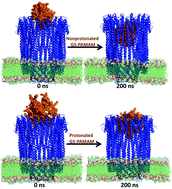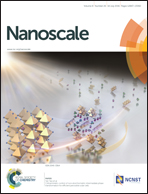pH controlled gating of toxic protein pores by dendrimers†
Abstract
Designing effective nanoscale blockers for membrane inserted pores formed by pore forming toxins, which are expressed by several virulent bacterial strains, on a target cell membrane is a challenging and active area of research. Here we demonstrate that PAMAM dendrimers can act as effective pH controlled gating devices once the pore has been formed. We have used fully atomistic molecular dynamics (MD) simulations to characterize the cytolysin A (ClyA) protein pores modified with fifth generation (G5) PAMAM dendrimers. Our results show that the PAMAM dendrimer, in either its protonated (P) or non-protonated (NP) states can spontaneously enter the protein lumen. Protonated dendrimers interact strongly with the negatively charged protein pore lumen. As a consequence, P dendrimers assume a more expanded configuration efficiently blocking the pore when compared with the more compact configuration adopted by the neutral NP dendrimers creating a greater void space for the passage of water and ions. To quantify the effective blockage of the protein pore, we have calculated the pore conductance as well as the residence times by applying a weak force on the ions/water. Ionic currents are reduced by 91% for the P dendrimers and 31% for the NP dendrimers. The preferential binding of Cl− counter ions to the P dendrimer creates a zone of high Cl− concentration in the vicinity of the internalized dendrimer and a high concentration of K+ ions in the transmembrane region of the pore lumen. In addition to steric effects, this induced charge segregation for the P dendrimer effectively blocks ionic transport through the pore. Our investigation shows that the bio-compatible PAMAM dendrimers can potentially be used to develop therapeutic protocols based on the pH sensitive gating of pores formed by pore forming toxins to mitigate bacterial infections.


 Please wait while we load your content...
Please wait while we load your content...